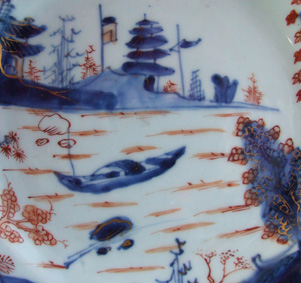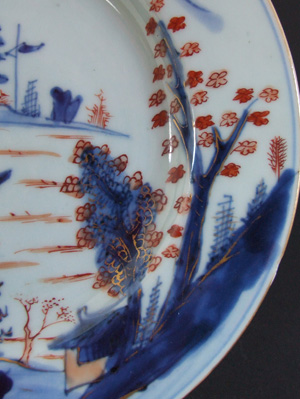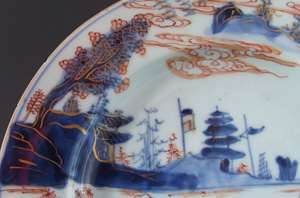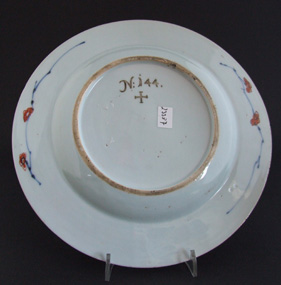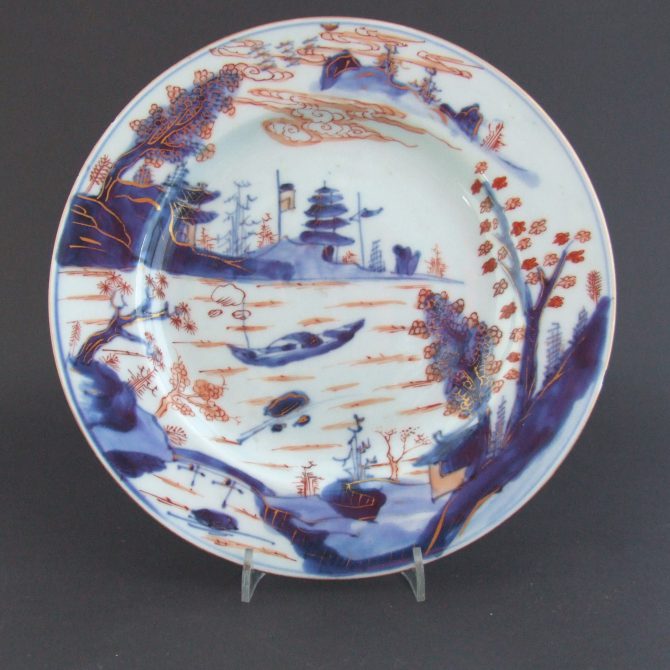
KANGXI 1662 – 1722 Chinese Export Porcelain
A Chinese Export Porcelain Plate from the Collection of Augustus the Strong (1670 – 1733). Kangxi Period c.1720. The Base with a Wheel Engraved Johanneum Inventory Mark, From The Royal Collection at The Japanese Palace, Dresden. Decorated in the Imari Palette of Underglaze Cobalt Blue with Overglaze Iron-Red and Gilding. The Scene is of a Small Boat Framed by Land Joined by a Bridge in the Foreground. The Distance Consists of a Hills and Mountains with a Pagoda and Smaller Buildings.
SOLD
- Condition
- In very good condition, one shallow (mostly glaze) chip c.10mm, two tiny glaze frits.
- Size
- Diameter : 22 cm (8 3/4 inches)
- Provenance
- Augustus the Strong (1670 - 1733). The Royal Collection at The Japanese Palace, Dresden, Wheel Engraved Johanneum Inventory Mark N : 144 + . This is under the heading `Japanese Porcelain`, Appendix 3. `Table Services and Accessories`. This was supplied by Bassetouche and were entered in the inventory in 1721.
- Stock number
- 233871
Information
Chinese Imari Porcelain :
Imari Porcelain is the European collectors` name for a type of Japanese Porcelain made in the town of Arita, in the former Hizen Province, north western Kyūshū, and exported via the port of Imari, specifically for the European Export trade.Imari was simply the trans-shipment port for Arita wares, no porcelain was made there. The kilns at Arita formed the heart of the Japanese Porcelain industry, which developed in the early 17th century, after the white kaolin clay was discovered in 1616 by abducted Korean potter Yi Sam Pyeong (1579-1655). Although Imari originating in Japan the tern is used to describe a whole range of ceramics from all over the world, they are all linked by their palette of underglaze cobalt blue, overglaze iron-red and gold. The Chinese Porcelain industry based at Jingdezhen made what they thought they could sell, like most potters in the 18th century they had no compunction in copying what was made elsewhere. It made perfect commercial sense, it was much safer to make something that had already been tried and tested on the market. The Chinese copied the Japanese Imari palette of underglaze cobalt blue enlivened with overglaze iron red and gilding, they also copied the Japanese patterns that used Imari colours, sometimes they shapes of vessels were copied too. Porcelain decorated with the Imari colour scheme would have looked very rich and opulent in flickering candle light on 18th century Western walnut and mahogany furniture. Indeed the colour scheme became so popular in the West during the 18th century that it was copied by most European Porcelain factories.
Augustus The Strong :
Augustus II (1670-1733) King of Poland and Elector of Saxony known as Augustus the Strong. Augustus`s great physical strength earned him the nicknames `the Strong`, `Saxon Hercules` and `Iron Hand`. He liked to show that he lived up to his name by breaking horse shoes with his bare hands. His ancestor Cymburgis of Masovia was also noted for her strength. Augustus the Strong owed allegiance to the Imperial Habsburgs as a member of the Order of the Golden Fleece. Augustus the Strong owed allegiance to the Imperial Habsburgs as a member of the Order of the Golden Fleece. As Elector of Saxony, he is perhaps best remembered as a patron of the arts and architecture. He established the Saxon capital of Dresden as a major cultural centre, attracting artists and musicians from across Europe to his court. Augustus also amassed an impressive art collection and built fantastic baroque palaces at Dresden and at Warsaw. As a politician, he is nowadays not held in high esteem in Poland, getting blamed for embroiling the Polish-Lithuanian Commonwealth in the Great Northern War. His attempts at internal reforms and at bolstering the royal power are considered to have come to naught, while his policies are said to have allowed the Russian Empire to strengthen its influence over the Polish-Lithuanian Commonwealth.
The Japanisches Palais (Japanese Palace):
The Japanese Palace is a Baroque building in Dresden, Germany, on the Neustadt bank of the river Elbe. Built in 1715, it was extended from 1729 until 1731 to store the porcelain collection of Augustus the Strong that is now part of the Dresden Porcelain Collection. However, it was never used for this purpose, and instead served as a library.
